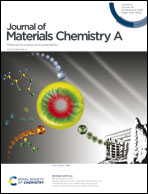A supercapacitor with ultrahigh volumetric capacitance produced by self-assembly of reduced graphene oxide through phosphoric acid treatment†
Abstract
Reduced graphene oxide (RGO) with a porous nanostructure and large surface area suffers from poor volumetric capacitance when it is employed in supercapacitors. This paper reports a facile, scalable and efficient method to produce self-assembled reduced graphene oxide with high packing density (1.55 g cm−3) via phosphoric acid treatment (PAT) at moderate temperatures (200–400 °C). The PAT process could not only controllably preserve redox-active C–OH and C![[double bond, length as m-dash]](https://www.rsc.org/images/entities/char_e001.gif) O groups which can provide large and stable pseudocapacitance, but also contribute to the formation of a well self-assembled compact structure. Due to the pseudocapacitive behavior of the electrochemically active oxygen functional groups as well as the compact layered structure, the reduced graphene oxide (RGO-MP40) exhibits an ultrahigh volumetric capacitance (482 F cm−3 and 384 F cm−3 at a mass loading of 2.5 mg cm−2 and 19.7 mg cm−2, respectively). This novel strategy holds great promise for designing graphene-based materials for compact energy-storage devices.
O groups which can provide large and stable pseudocapacitance, but also contribute to the formation of a well self-assembled compact structure. Due to the pseudocapacitive behavior of the electrochemically active oxygen functional groups as well as the compact layered structure, the reduced graphene oxide (RGO-MP40) exhibits an ultrahigh volumetric capacitance (482 F cm−3 and 384 F cm−3 at a mass loading of 2.5 mg cm−2 and 19.7 mg cm−2, respectively). This novel strategy holds great promise for designing graphene-based materials for compact energy-storage devices.



 Please wait while we load your content...
Please wait while we load your content...